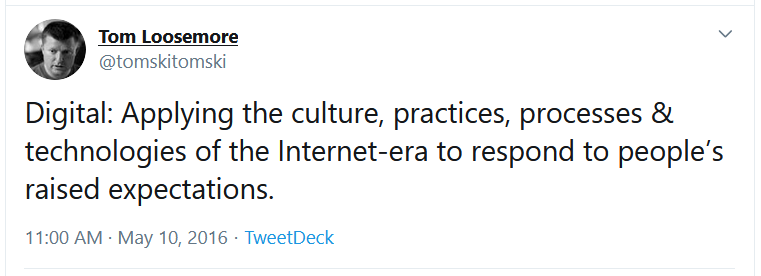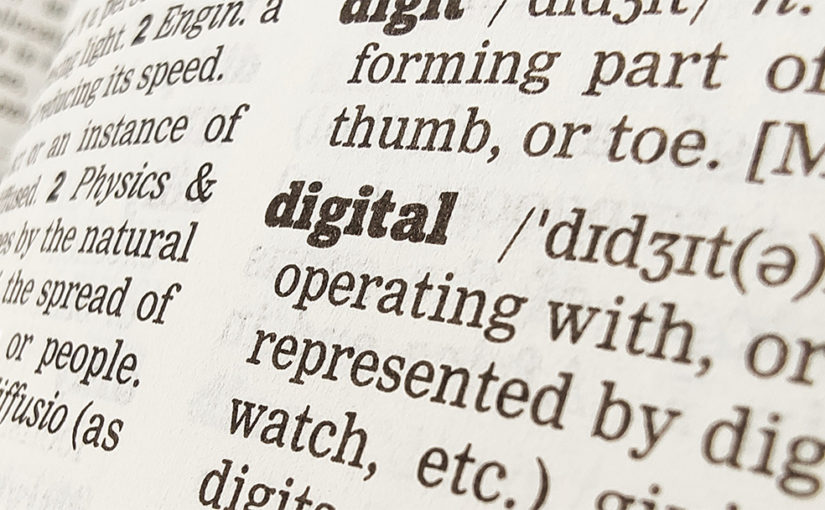One of the challenges in looking at the experience of digital in UK unions is that there isn’t really any single accepted definition of ‘digital’ across the movement. Different unions currently have quite different conceptions of what digital means to them.
At one end of the spectrum unions have a very narrow conception of digital as what might be termed “digital communications”. This is the part of the union’s comms function that deals explicitly with social media, web content, mass email etc.
(This isn’t to say that’s not also important in and of itself. There has been some great work in recent years from unions in professionalising their digital comms work, and it needs to continue.)
At the other end of the spectrum, some unions had a much broader conception of digital, which encompassed digital communications, along with some traditional “IT” functions and strategic functions such as service planning.
The dominant view in contemporary ‘digital transformation’ literature is that developing a broader conception of what digital means in the organisation is in itself a part of the transformation process.
So where to look for examples? Well, the Co-op, NCVO and Government Digital Services (GDS) all have working definitions of digital similar to that devised by GDS co-founder Tom Loosemore:

Under this definition, applying concepts such as user-centred-design and iterative development to the redesign of organisational processes could be considered ‘digital’ because they use the approaches of the internet era, even though they may not necessarily be building, using or deploying a new technology in every instance (however, given digital is now the air we breathe, very few of the projects we take won’t have a digital dimension from now on).
Another useful perspective is outlined by Cassie Robinson, Head of Digital Grant Making at The National Lottery Community Fund. She splits digital initiatives into eight types based on the applications for grants that her organisation receives.
For her, ‘digital’ covers work around: “Digitising processes”, “Basic Digital Infrastructure”, “Digital skills and digital inclusion”, “Designing new services”, “Digital Engagement”, “Digital innovation”, “Organisational redesign and transition” and “Digital practices and good leadership”. All those things are in scope when we talk about digital.
Broadening unions’ own understanding of what counts as digital will be an important step in helping the whole organisation work together more effectively on digital change projects.
A wider concept of what digital means for the union will help them to increase the involvement of different people across the organisation and draw on a wider base of skills and experience.
Adopting a broader digital transformation definition could also help unions to make the most appropriate use of digital. There is a risk that organisations try to update outdated processes and activities by bringing new tools to bear on the same old task – a digital lick of paint that delivers a marginal benefit but leaves the original functions unchanged.
The TUC’s Virtual Chief Information Officer, Simon Parry, likens it to the effects of electrification of industry. When electrical motors replaced steam engines, many companies failed to see the productivity boost they had initially expected.
Steam engines powered a shaft that in turn powered all the machines – the whole factory needed to be structured around it. Those factories that just replaced the steam engine with a big electric motor saw cleaner factories, but no difference in operations, and big costs.
It wasn’t until factories realised the new technology needed an entirely new approach – multiple smaller motors placed nearer to the machines – that they were able to design factories from the ground up, and to work far more efficiently.
In some cases, a deeper view of what digital transformation means – looking at the union’s aims and values, and reinventing them for the new digital-first environment – could result in much greater productivity gains than simply trying to use technology to do the same things, only a bit faster.
This post was adapted from the Digital Lab report “Digital in UK unions: measuring our digital journey”, which you can download in full here.

